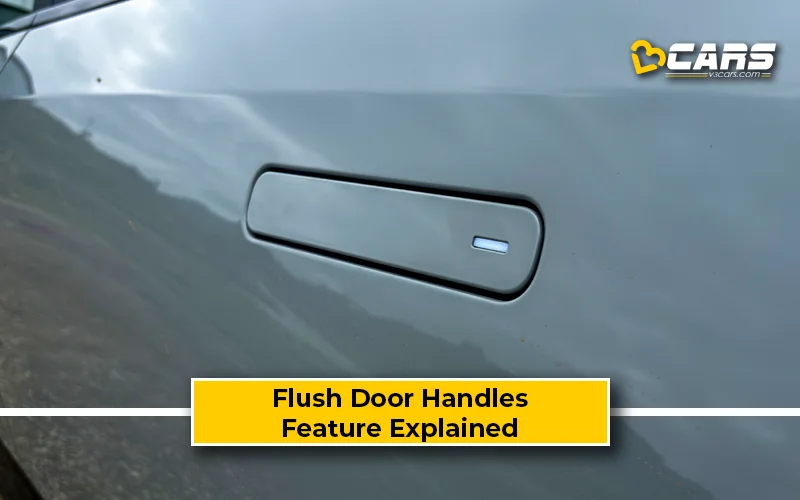Flush Door Handles – Feature Explained
Flush door handles are one of those car features that instantly make a vehicle look modern, aerodynamic and tech-forward. What started as a premium design element on luxury cars and SUVs is now slowly making its way into more affordable cars in India. In this Feature Explained article, we break down what flush door handles are, how they work, their pros and cons, and whether you can retrofit them on your own car.

What Are Flush Door Handles?
Flush door handles are door handles that sit level with the body surface of the car instead of protruding outward like conventional door handles. When the car is locked, the handle is almost invisible from the side profile, giving the car a seamless, clean, and futuristic appearance.
Depending on the design, flush door handles either pop out electrically or tilt outward mechanically when the car detects the key nearby or when you touch a designated area on the handle.
The primary reasons manufacturers use flush door handles are:
- Improved aerodynamics
- Cleaner exterior styling
- Premium visual appeal
- Better integration with modern EV design language
How Do Flush Door Handles Work?
Flush door handles work in one of two ways, depending on the system used by the manufacturer:
Electrically Deploying Flush Door Handles
These use small electric motors inside the door assembly. They pop out automatically when:
- You unlock the car via remote
- The car detects the key in close proximity
- You press a touch-sensitive pad on the handle
When the vehicle is locked or starts moving, the handles retract back into the door panel.
Popular examples that use electrically deploying flush door handles include EVs and SUVs such as the Tata Curvv EV and Kia EV6.
Mechanically Linked Flush Door Handles
These are simpler in operation. The handle sits flush but pops out manually when you press a section of it, similar to a push-pull mechanism. They do not use motors and hence, they are easier to maintain.
Popular examples that use this type of door handles include the Tata Harrier and Safari.
What Are The Pros And Cons Of Flush Door Handles?
Here are the pros, or advantages, of flush door handles in cars:
- Cleaner design: Flush door handles give the car a minimalist and premium appearance.
- Better aerodynamics: Reducing drag improves efficiency, especially in EVs.
- Reduced wind noise: With fewer protrusion, airflow around the body is smoother.
- Modern and high-tech feel: They are now associated with next-gen car designs.
Here are the cons, or disadvantages of flush door handles in cars:
- Less intuitive for some users: older passengers may take time to understand the mechanism.
- More complex to repair: Electrically-actuated flush door handles use sensors and complex motors.
- Can freeze or jam in extreme climates: Cold weather or dust accumulation can affect operation.
- Higher manufacturing cost: Which is why this feature is usually seen on more expensive models and variants.
Can Flush Door Handles Be Fitted From The Aftermarket?
Technically, yes. But practically, it is not recommended. Aftermarket flush door handle kits exist, but installing them requires:
- Cutting or modifying the door panels
- Rewiring the electric system
- Integrating sensors and lock mechanisms
- Ensuring water resistance
- Recalibrating the central locking mechanism
Aftermarket flush door handles can compromise:
- Door structural integrity
- Side-impact protection
- Water sealing
- Warranty for the vehicle
- Reliability of the locking mechanism
OEM flush door handles are engineered along with the door structure. Retrofitting them is risky and usually ends up costing more than what it’s worth.
How Expensive Is It To Repair Flush Door Handles?
Repair costs depend on whether the handle is mechanical or electric.
Mechanical Flush Handles
- Approx Rs. 2,000 - Rs. 6,000 for parts
- Labour depends on door trim removal
Electric Flush Handles
- Rs. 8,000 - Rs. 25,000 for the handle module
- Additional cost for sensors or motor replacement
- More labour-intensive due to wiring and calibration
Luxury cars and EVs with sophisticated auto-deploy systems may go as high as Rs. 35,000 - Rs. 60,000 per handle. Also, in accidental repairs, replacing flush handles is costlier because the mechanism is integrated deeper inside the door.
Also Read: Hill Start Assist Or Hill Hold Control - Feature Explained
Helpful Tools:
- Fuel Cost Calculator for Cars – Know your monthly fuel expense based on usage and mileage
- Car On-Road Price Calculator – Convert ex-showroom to on-road price for any city
Sell Used Car Online – Enter your car and contact details to get an instant price estimate and book a free inspection with our partner network



0 Comments